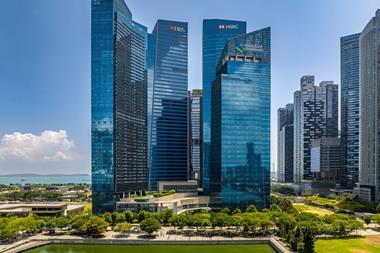The optimal combination of performance, size, liquidity, and relative risk make Japan an attractive destination for property investment. With half of the investible real estate assets in Asia, the country is too big to be ignored in a global or regional portfolio and there has been a surge of interest from both domestic and foreign investors.
Investment transactions in office and retail property in Tokyo have increased over 13-fold in four years to circa US$30bn (€21bn) in 2006. This high level of activity is set to continue with the good fundamentals and the positive yield spread that compares favourably with other major global countries. Because of a traditionally high owner-occupation rate among Japanese retailers, the history of the retail property investment market is relatively new and the market is underdeveloped compared with office property. However, there are ongoing dynamic structural changes in the sector and investment opportunities are increasing.
After Japanese consumer spending peaked in 1992, the retail market faced general downward pressure for more than a decade. This led to a string of bankruptcies and financial difficulties among retailers. After the prolonged economic recession, however, Japan has finally emerged to enjoy gradual but sustainable economic growth that is supported by rising levels of capital investment, exports, and labour productivity. The Bank of Japan ended its zero-interest rate policy in July 2006, which was a symbolic gesture indicating that the economy had entered a growth cycle. Yet the long erosion of consumer confidence has been slow to reverse, with Japanese consumers taking a long time to change their restrictive spending habits. Although retail sales have been growing for four consecutive years, the growth speed is only CAGR 0.5% from the trough in 2002, in contrast to GDP growth of CAGR 2.1% in the same period. In the longer term, growth in the Japanese retail sector should gradually align with broader economic growth.
Despite the recent improvement in the economy, there remains a series of risks and structural challenges facing the Japanese economy. At a global level, the recent financial turmoil caused by the US sub-prime loan crisis poses the most immediate risk, with Japan's exports being susceptible to a potential slowdown in US economic growth and consumption. Domestically, Japan faces structural challenges associated with a declining population that will pose difficulties for sustaining stronger growth over the longer term. Despite these risks and weaknesses, the structural changes that are underway mean the economic outlook remains robust, particularly in relation to the demand for retail space.
The Japanese retail market has been very fragmented, with the market share of the top three retailers accounting for only 9% of the aggregate retail food sales in Japan, compared with 53% in France and 27% in the US in 2003. The latest trend in the sector, however, is the growing popularity of large-scale shopping centres, with the leading retailers increasing their market shares through organic growth and M&A activities. The sales share of shopping centres against the retail market in Japan has almost doubled in the last 15 years, from only 11.4% in 1991 to 20.6% in 2005, according to Japan Council of Shopping Centres. In the last decade, 70-80% of new shopping centres were developed in suburban areas, typically alongside major roads.
Amendments to Japan's City Planning Law, adopted in May 2006, will regulate development of large-scale commercial facilities such as shopping centres and outlet malls in suburban areas. When the law comes into effect in late 2007, the opening of new shopping centres will be limited within city centres. This change has made existing store portfolios in the suburbs extremely valuable, and shopping centres have become a popular asset class for developers, private funds, and J-REITs to acquire. Owner occupation is being gradually replaced by sale-and-leaseback, which also helps strengthen the balance sheets of debt-laden retailers. The introduction of the impairment valuation rule on fixed assets in March 2006 also accelerated leaseback transactions. Reflecting these structural changes as well as growing competition, the expected cap rates for retail property in suburban Tokyo fell from 9% in 2002 to 5.5% in April 2007 according to the Japan Real Estate Investor Survey (by Japan Real Estate Institute).
Contrary to sales growth in shopping centres, department store sales fell 0.7% to ¥7.8trn (€48bn), in 2006, making it the ninth straight year of decline, according to the Japan Department Stores Association. Consolidation is rapidly taking place among major department stores. Seibu Department Store and Sogo joined forces in 2003 to create Millennium Retailing, now part of Seven & I Holdings. Daimaru merged with Matsuzakaya in Sept 2007 to create the largest department store chain in the country, J.Front Retailing. Furthermore, Isetan and Mitsukoshi have agreed to consolidate their operations to create an even bigger chain. The dominant tenure for Japanese department stores is owner occupation and lease contracts are still rare.
Sales of luxury goods in Japan were not battered even during sluggish economic conditions. Leading European and domestic luxury shops opened flagship stores in Ginza, Omotesando (both in Tokyo) and in Shinsai-bashi (Osaka) in order to increase brand prestige and market share. Accordingly, investment in retail properties expanded, with the Japan Real Estate Investor Survey reporting the expected cap rate for high-street retail properties at just 4% in Central Tokyo in 3Q 2006, a level where it has since stabilised.
As a result, the market is rapidly maturing with structural changes that have stimulated greater liquidity and transparency while increasing investment options and vehicles. Several retail-property-dedicated J-REITs are listed on Tokyo Stock Exchange. It should also be noted that a supermarket that has a master lease contract with the owner of the shopping centre tends to control the sub-letting process for the in-line tenants rather than the shopping centre owner.
Koichiro Obu is vice president of RREEF












